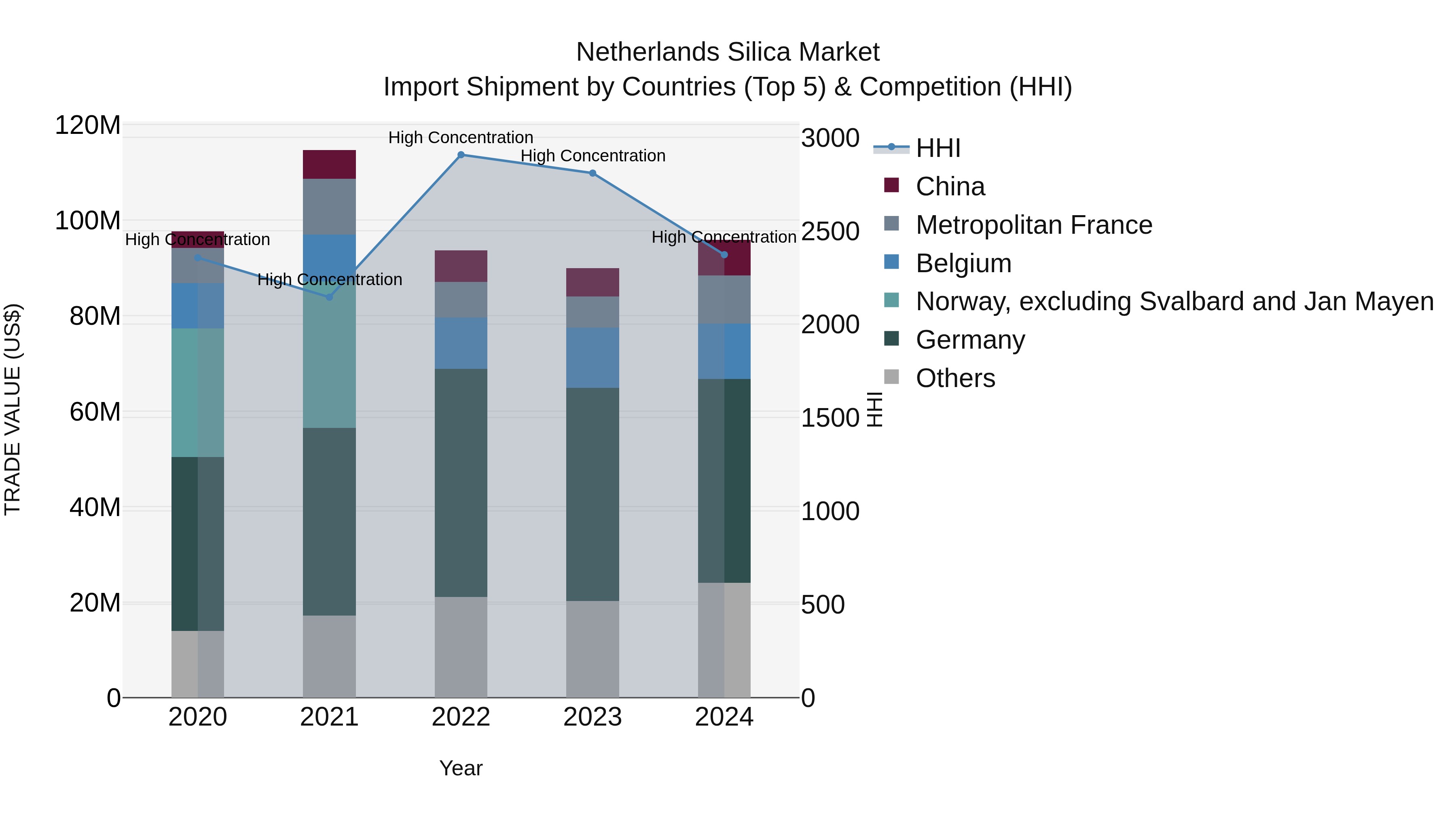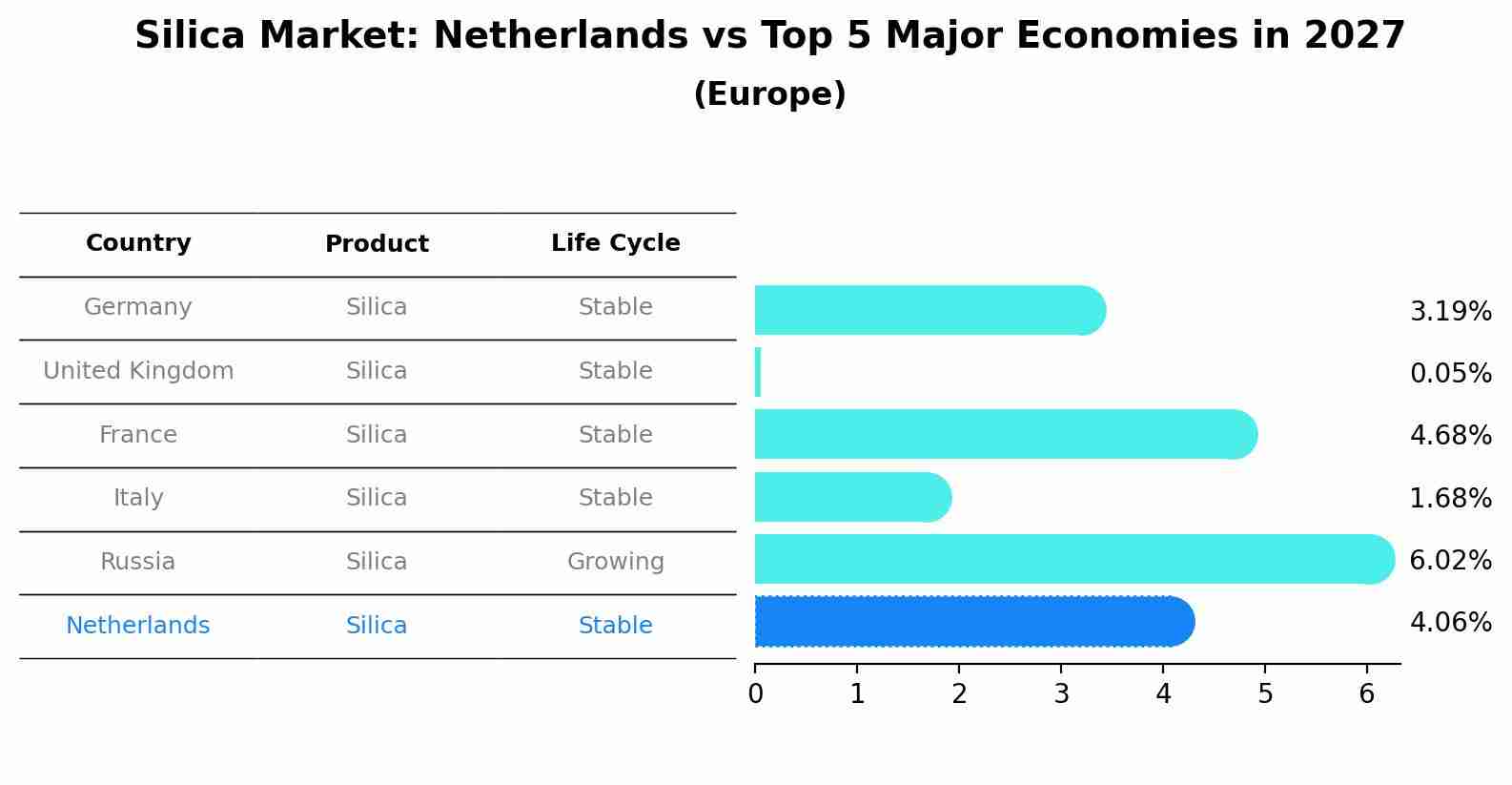Netherlands Silica Market (2025-2031) | Share, Revenue, Analysis, Companies, Growth, Industry, Outlook, Value, Trends, Size, Forecast & Segmentation
| Product Code: ETC5318614 | Publication Date: Nov 2023 | Updated Date: Nov 2025 | Product Type: Market Research Report | |
| Publisher: 6Wresearch | Author: Ravi Bhandari | No. of Pages: 60 | No. of Figures: 30 | No. of Tables: 5 |
Netherlands Silica Market Top 5 Importing Countries and Market Competition (HHI) Analysis
In 2024, the Netherlands continued to be a key importer of silica, with top countries exporting being Germany, Belgium, Metropolitan France, China, and the UK. Despite a slight decline in the compound annual growth rate (CAGR) from 2020-24 at -0.46%, there was a notable growth rate of 6.54% from 2023-24. The market showed high concentration with a high Herfindahl-Hirschman Index (HHI) in 2024, indicating a strong competitive landscape among the top exporting countries. This data suggests a steady demand for silica imports in the Netherlands market.

Silica Market: Netherlands vs Top 5 Major Economies in 2027 (Europe)
The Silica market in Netherlands is projected to grow at a stable growth rate of 4.06% by 2027, within the Europe region led by Germany, along with other countries like United Kingdom, France, Italy and Russia, collectively shaping a dynamic and evolving market environment driven by innovation and increasing adoption of emerging technologies.

Key Highlights of the Report:
- Netherlands Silica Market Outlook
- Market Size of Netherlands Silica Market, 2024
- Forecast of Netherlands Silica Market, 2031
- Historical Data and Forecast of Netherlands Silica Revenues & Volume for the Period 2021-2031
- Netherlands Silica Market Trend Evolution
- Netherlands Silica Market Drivers and Challenges
- Netherlands Silica Price Trends
- Netherlands Silica Porter`s Five Forces
- Netherlands Silica Industry Life Cycle
- Historical Data and Forecast of Netherlands Silica Market Revenues & Volume By Application for the Period 2021-2031
- Historical Data and Forecast of Netherlands Silica Market Revenues & Volume By Rubber for the Period 2021-2031
- Historical Data and Forecast of Netherlands Silica Market Revenues & Volume By Construction for the Period 2021-2031
- Historical Data and Forecast of Netherlands Silica Market Revenues & Volume By Agrochemicals for the Period 2021-2031
- Historical Data and Forecast of Netherlands Silica Market Revenues & Volume By Oral Care for the Period 2021-2031
- Historical Data and Forecast of Netherlands Silica Market Revenues & Volume By Food & Feed for the Period 2021-2031
- Historical Data and Forecast of Netherlands Silica Market Revenues & Volume By Others for the Period 2021-2031
- Netherlands Silica Import Export Trade Statistics
- Market Opportunity Assessment By Application
- Netherlands Silica Top Companies Market Share
- Netherlands Silica Competitive Benchmarking By Technical and Operational Parameters
- Netherlands Silica Company Profiles
- Netherlands Silica Key Strategic Recommendations
Frequently Asked Questions About the Market Study (FAQs):
1 Executive Summary |
2 Introduction |
2.1 Key Highlights of the Report |
2.2 Report Description |
2.3 Market Scope & Segmentation |
2.4 Research Methodology |
2.5 Assumptions |
3 Netherlands Silica Market Overview |
3.1 Netherlands Country Macro Economic Indicators |
3.2 Netherlands Silica Market Revenues & Volume, 2021 & 2031F |
3.3 Netherlands Silica Market - Industry Life Cycle |
3.4 Netherlands Silica Market - Porter's Five Forces |
3.5 Netherlands Silica Market Revenues & Volume Share, By Application, 2021 & 2031F |
4 Netherlands Silica Market Dynamics |
4.1 Impact Analysis |
4.2 Market Drivers |
4.2.1 Growing demand for silica in the construction industry for applications such as concrete, glass, and ceramics. |
4.2.2 Increasing use of silica in the electronics and semiconductor industry for manufacturing components like silicon wafers. |
4.2.3 Rising demand for silica in the automotive industry for producing tires, coatings, and parts. |
4.3 Market Restraints |
4.3.1 Fluctuating prices of raw materials used in silica production, impacting profit margins. |
4.3.2 Stringent regulations related to environmental concerns and worker safety affecting silica mining and processing operations. |
4.3.3 Competition from alternative materials like synthetic silica substitutes affecting market growth. |
5 Netherlands Silica Market Trends |
6 Netherlands Silica Market Segmentations |
6.1 Netherlands Silica Market, By Application |
6.1.1 Overview and Analysis |
6.1.2 Netherlands Silica Market Revenues & Volume, By Rubber, 2021-2031F |
6.1.3 Netherlands Silica Market Revenues & Volume, By Construction, 2021-2031F |
6.1.4 Netherlands Silica Market Revenues & Volume, By Agrochemicals, 2021-2031F |
6.1.5 Netherlands Silica Market Revenues & Volume, By Oral Care, 2021-2031F |
6.1.6 Netherlands Silica Market Revenues & Volume, By Food & Feed, 2021-2031F |
6.1.7 Netherlands Silica Market Revenues & Volume, By Others, 2021-2031F |
7 Netherlands Silica Market Import-Export Trade Statistics |
7.1 Netherlands Silica Market Export to Major Countries |
7.2 Netherlands Silica Market Imports from Major Countries |
8 Netherlands Silica Market Key Performance Indicators |
8.1 Average selling price of silica products in the Netherlands market. |
8.2 Number of new construction projects utilizing silica-based products. |
8.3 Percentage of silica products meeting environmental and safety standards in the market. |
9 Netherlands Silica Market - Opportunity Assessment |
9.1 Netherlands Silica Market Opportunity Assessment, By Application, 2021 & 2031F |
10 Netherlands Silica Market - Competitive Landscape |
10.1 Netherlands Silica Market Revenue Share, By Companies, 2024 |
10.2 Netherlands Silica Market Competitive Benchmarking, By Operating and Technical Parameters |
11 Company Profiles |
12 Recommendations | 13 Disclaimer |
- Single User License$ 1,995
- Department License$ 2,400
- Site License$ 3,120
- Global License$ 3,795
Search
Thought Leadership and Analyst Meet
Our Clients
Related Reports
- Vietnam System Integrator Market (2025-2031) | Size, Companies, Analysis, Industry, Value, Forecast, Growth, Trends, Revenue & Share
- ASEAN and Thailand Brain Health Supplements Market (2025-2031) | Strategy, Consumer Insights, Analysis, Investment Trends, Opportunities, Growth, Size, Share, Industry, Revenue, Segments, Value, Segmentation, Supply, Forecast, Restraints, Outlook, Competition, Drivers, Trends, Demand, Pricing Analysis, Competitive, Strategic Insights, Companies, Challenges
- ASEAN Bearings Market (2025-2031) | Strategy, Consumer Insights, Analysis, Investment Trends, Opportunities, Growth, Size, Share, Industry, Revenue, Segments, Value, Segmentation, Supply, Forecast, Restraints, Outlook, Competition, Drivers, Trends, Demand, Pricing Analysis, Competitive, Strategic Insights, Companies, Challenges
- Europe Flooring Market (2025-2031) | Outlook, Share, Industry, Trends, Forecast, Companies, Revenue, Size, Analysis, Growth & Value
- Saudi Arabia Manlift Market (2025-2031) | Outlook, Size, Growth, Trends, Companies, Industry, Revenue, Value, Share, Forecast & Analysis
- Uganda Excavator, Crane, and Wheel Loaders Market (2025-2031) | Strategy, Consumer Insights, Analysis, Investment Trends, Opportunities, Growth, Size, Share, Industry, Revenue, Segments, Value, Segmentation, Supply, Forecast, Restraints, Outlook, Competition, Drivers, Trends, Demand, Pricing Analysis, Competitive, Strategic Insights, Companies, Challenges
- Rwanda Excavator, Crane, and Wheel Loaders Market (2025-2031) | Strategy, Consumer Insights, Analysis, Investment Trends, Opportunities, Growth, Size, Share, Industry, Revenue, Segments, Value, Segmentation, Supply, Forecast, Restraints, Outlook, Competition, Drivers, Trends, Demand, Pricing Analysis, Competitive, Strategic Insights, Companies, Challenges
- Kenya Excavator, Crane, and Wheel Loaders Market (2025-2031) | Strategy, Consumer Insights, Analysis, Investment Trends, Opportunities, Growth, Size, Share, Industry, Revenue, Segments, Value, Segmentation, Supply, Forecast, Restraints, Outlook, Competition, Drivers, Trends, Demand, Pricing Analysis, Competitive, Strategic Insights, Companies, Challenges
- Angola Excavator, Crane, and Wheel Loaders Market (2025-2031) | Strategy, Consumer Insights, Analysis, Investment Trends, Opportunities, Growth, Size, Share, Industry, Revenue, Segments, Value, Segmentation, Supply, Forecast, Restraints, Outlook, Competition, Drivers, Trends, Demand, Pricing Analysis, Competitive, Strategic Insights, Companies, Challenges
- Israel Intelligent Transport System Market (2025-2031) | Strategy, Consumer Insights, Analysis, Investment Trends, Opportunities, Growth, Size, Share, Industry, Revenue, Segments, Value, Segmentation, Supply, Forecast, Restraints, Outlook, Competition, Drivers, Trends, Demand, Pricing Analysis, Competitive, Strategic Insights, Companies, Challenges
Industry Events and Analyst Meet
Whitepaper
- Middle East & Africa Commercial Security Market Click here to view more.
- Middle East & Africa Fire Safety Systems & Equipment Market Click here to view more.
- GCC Drone Market Click here to view more.
- Middle East Lighting Fixture Market Click here to view more.
- GCC Physical & Perimeter Security Market Click here to view more.
6WResearch In News
- Doha a strategic location for EV manufacturing hub: IPA Qatar
- Demand for luxury TVs surging in the GCC, says Samsung
- Empowering Growth: The Thriving Journey of Bangladesh’s Cable Industry
- Demand for luxury TVs surging in the GCC, says Samsung
- Video call with a traditional healer? Once unthinkable, it’s now common in South Africa
- Intelligent Buildings To Smooth GCC’s Path To Net Zero


















